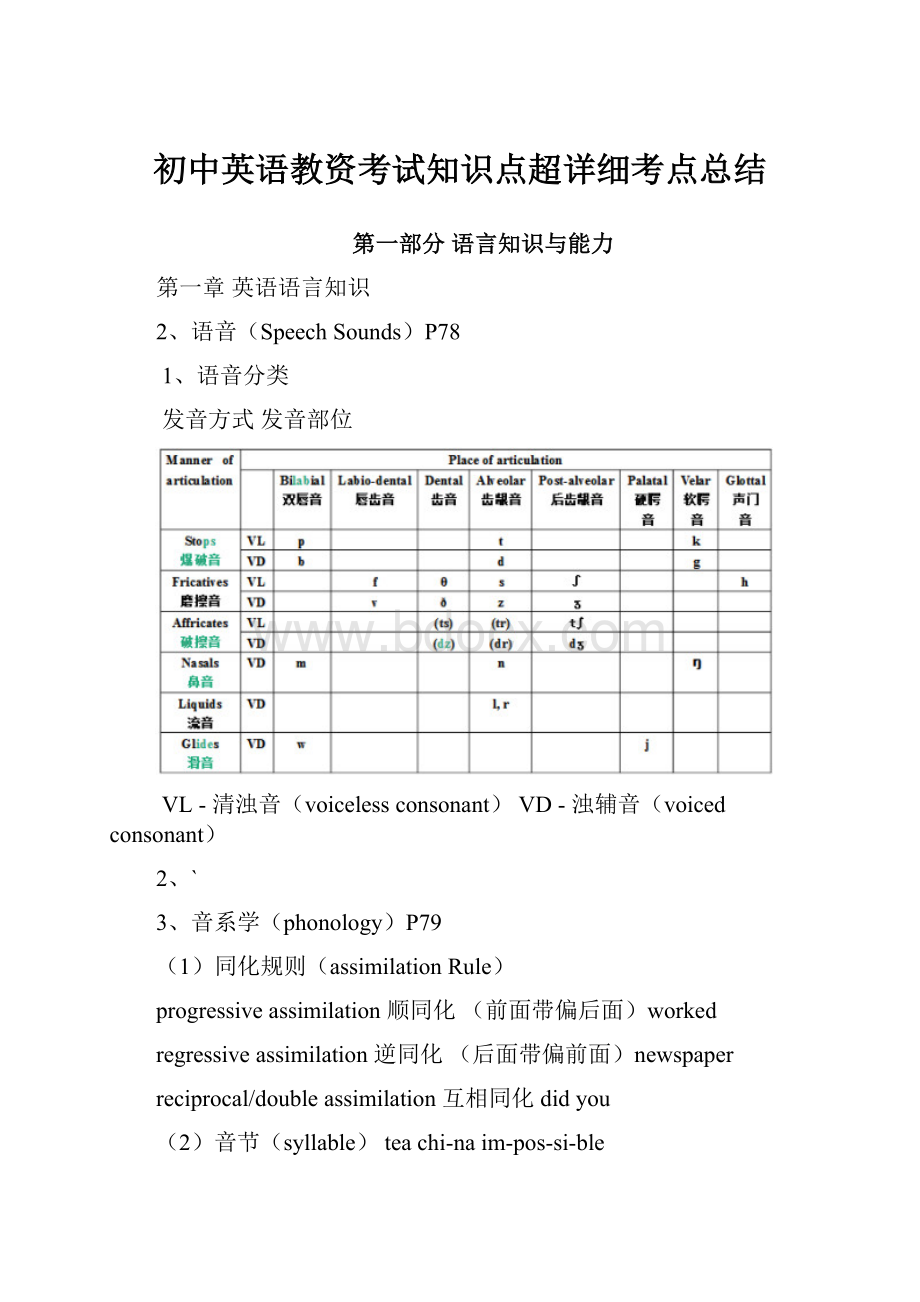初中英语教资考试知识点超详细考点总结.docx
《初中英语教资考试知识点超详细考点总结.docx》由会员分享,可在线阅读,更多相关《初中英语教资考试知识点超详细考点总结.docx(47页珍藏版)》请在冰豆网上搜索。

初中英语教资考试知识点超详细考点总结
第一部分语言知识与能力
第一章英语语言知识
2、语音(SpeechSounds)P78
1、语音分类
发音方式发音部位
VL-清浊音(voicelessconsonant)VD-浊辅音(voicedconsonant)
2、`
3、音系学(phonology)P79
(1)同化规则(assimilationRule)
progressiveassimilation顺同化(前面带偏后面)worked
regressiveassimilation逆同化(后面带偏前面)newspaper
reciprocal/doubleassimilation互相同化didyou
(2)音节(syllable)teachi-naim-pos-si-ble
重音(stress)声调(tone)
(3)语音变化(vocalvariety)
*
liaison连读pickitup
plosion爆破音
plosionloss失去爆破sitdown;incompleteplosion不完全爆破asked
nasalplosion鼻腔爆破button;lateralplosion舌边爆破little
3、形态学(Morphology)
1、morpheme词素重点!
P87
(1)freemorpheme自由词素dog;boundmorpheme黏着词素moonwalk
、
(2)root词根;affix词缀(prefix前缀、suffix后缀);stem词干friend-ships
(3)inflectionalaffix屈折词缀-s,-ing,-ed不同形式
(4)derivationalaffix派生词缀改变词性和意义
2、
(1)inflection屈折变化-s,-ing,-ed不同形式
(2)word-formation词的形成:
compounding复合法through-out
derivation派生法(prefixation前缀化suffixation后缀化)il-logical-ly
3、、
4、常见构词法P89
invention新创词nylon;blending混成法smoke+fog=smog
clipping截断法advertisement=ad;initialism首字母连写词WTO
acronym首字母拼音词AIDS;back-formation逆构词法editor--edit
analogicalcreation类似构词work--wrought/worked
typesofborrowing借词法:
loanword/borrowing借词feast(法语中借来)
loanblend混合借词Chinatown(本国加外来)
loanshift转移借词bridge(借用意义)
—
loantranslation翻译借词(从别种语言翻译而来)
5、词义变化
broadening词义扩大bird小鸟--鸟类;narrowing词义缩小girl年轻人--女孩
meaningshift词义转移;classshift词性转换;folketymology俗词源(错多了成了对的)
四、句法学(Syntax)P91
1、句法关系
!
syntagmaticrelation组合关系(horizontalrelation/chainrelation)构成同一形式、序列或结构
paradigmaticrelation聚合关系(verticalrelation/choicerelation)各要素可相互替换
relationofco-occurrence共现关系(不同集合的词语一起组成句子)
2、句子结构和成分
immediateconstituentanalysis直接成分分析法(IC分析法)
Theboyatetheapple.用树形图(treediagram)一般句子,主谓宾之类的
endocentricconstruction向心结构
¥
一个词或词组可以确定为中心(center)或中心词(head)twostonebridge一般名词/动词/形容词短语
exocentricconstruction离心结构
没有确定的中心或中心词Theboysmiled.一般动宾/系表结构
deepstructure深层结构(含义相同,说法不同)
surfacestructure表层结构(句子表述方式)
5、语义学(Semantics)P93
1、涵义关系(SenseRelations)lexicalrelation词汇关系
(1);
(2)同义关系(Synonymy)synonyms同义词
stylistic文体差别(formality)buy--perchase;dialectal地域差别underground--subway
collocational搭配差别accuse(of)--charge(with);
emotive情感差别thrifty--stingy;semantic语义差别enough--ample
(3)反义关系(Antonymy)antonyms反义词relationalopposites意义相反词
gradableantonymy等级反义warm--cool
complementaryantonymy互补反义boy--girl
converseantonymy反向反义关系buy--sell
(4)《
(5)上下义关系(Hyponymy)种类和成员
包括上坐标词(superordinate)和下义词(hyponymy)flower--rose/tulip
(6)一词多义(Polysemy)
(7)同音/同形异义现象(Homonymy)
homophone同音异义sun--son
homograph同形异义lie
completehomonym完全同音同形异义bank岸边;银行
2、[
3、句子逻辑关系iff--充分必要条件“SistrueiffP”P就是S的真值条件(truthcondition)P
(1)synonymy同义关系“XissynonymouswithY.”同真同假P95
(2)contradiction矛盾关系“XisinconsistentwithY.”一真一假
(3)entailment蕴含关系“XentailsY.”X小,Y大X:
oldmanY:
man
(4)presupposition预设关系“XpresupposesY.”Y是前提X:
repairthecarY:
haveacar
6、语用学(Pragmatics)P96
1、言语行为理论(SpeechActTheory)
(1)…
(2)locutionaryact发话行为(说话人表达字面意思)
istheactofsayingsomethingwhichismeaningfulancanbeunderstood.
(3)illocutionaryact行事行为(说话人表达意图)
istheactinsayingsomethingtoperformafunction.
(4)perlocutionaryact取效行为(作用于听话人的效果)
istheresultsoreffectsthatareproducedbymeansofsayingsomething.
言外之意(illocutionarypoint):
representatives阐述类;directives指令类;commissives承诺类;
】
expressives表达类;declarations宣告类
2、会话含义理论(ConversationalPrinciple/Maxim)violate违反P97
cooperativeprinciple,CP合作原则(会话有共同目标)
“Makeyourconversationalcontributionsuchasisrequired,atthestageatwhichitoccurs,bytheacceptedpurposeordirectionofthetalkexchangeinwhichyouareengaged.”
(1)themaximofquantity数量准则(信息充分)
(2)themaximofquality质量准则(说实话)
(3)themaximofrelation相关准则(说相关的事)
(4)|
(5)themaximofmanner方式准则(清楚简洁避免歧义)
conversationalimplicature会话含义(用会话准则暗示意义)
(1)calculability可推导性(含义能理解)
(2)cancellability可取消性(defeasibility)(因素变化,含义变化)
(3)non-detachability不可分离性(含义依附于内容)
(4)non-conventionality非规约性(含义不确定)
7、~
8、修辞学(Rhetoric)问法:
rhetoric/rhetoricaldevice修辞策略P98
1、simile明喻like,as...as,asif,asthough,similarto,suchas
2、metaphor隐喻(暗含比较)elephantpause
3、personification拟人(把事物或概念当做人)
4、metonymy借代(用事物的名称代替亲密相关的另一事物)
5、synecdoche提喻(部分代替整体或整体代替部分)hand/mouth--man
6、euphemism婉言die--passaway
7、irony反语(意思相反)
$
8、allegory讽喻
9、exaggeration夸张(夸大或缩小使表达生动有趣)
10、transferredepithet移位修辞nervousexam
11、oxymoron矛盾修辞bitter-sweetmemory
12、pun双关语(homophonicpuns谐音双关;homographicpuns语义双关)
9、语言教学P100
1、中介语(interlanguage)
;
2、对比分析(contrastiveanalysis)
3、错误分析(erroranalysis)
(1)error错误(因为知识不足)
mistake失误(不注意犯错)
(2)interlingualerrors语际错误(迁移错误)因为母语Cnglish
intralingualerrors语内错误(发展性错误)因为过度概括语言规则eat-eated(错)
4、错误性质:
omissions省略(少成分);additions添加(多成分);
~
misformations形式错误(eated);
doublemarkings双重标记(didn’twent);misorderings顺序错误(howyouare)
5、我国外语学习者错误类型
(1)negativetransfer负迁移/干扰因为母语
(2)over-generalization过度类推/过度概括因为过度概括语言规则
(3)pragmaticfailure语用错误违反对方的文化习俗
6、第二外语习得理论(SecondLanguageAcquisition,SLA)
(1)Acquisition-LearningHypothesis语言习得和学得假说(习得和学得两条不同的途径)
{
(2)MonitorHypothesis语言监察假说(学习者自己监督控制语言输出质量)
(3)InputHypothesis语言输入假说(接触理解可理解性语言输入comprehensibleinput)
(4)AffectiveFilterHypothesis情感过滤假说(输入input和吸收intake受到动力motivation、性格personality、情感状态affectivestate)
(5)NaturalOrderHypothesis自然顺序假说(可以不按任何语法顺序来教学)
第2章英语语言运用能力
1、教学中的非语言交际
1、,
2、非语言手段P118
environmentlanguage环境语(座位安排、时间信息、室内标示装饰、声音灯光等)
objectlanguage客体语(个人,衣着化妆、个人用品等)
3、非语言行为
bodylanguage体态语(身姿、手势、表情、目光)
paralanguage副语言(声音音质、音量、语调、语速)
第3章!
第4章英语国家的语言、历史和文学
三、语言、文化和社会
1、局部结构P131
毗邻对(adjacencypairs)一轮对话
(1)毗邻对的条件相关性(conditionalrelevance)
preferredsecondpart/preferencestructure优选结构Hi
dispreferredsecondpart/dispreferencestructure非优选结构
relevantabsence相关缺失
(2)—
(3)毗邻对的扩展
basepairs根毗邻对(被其他会话扩展之前的毗邻对)
前扩展,指前序列(pre-sequences),包括邀请、请求、结束、宣告
中扩展,包括插入序列(insertionsequences)和旁侧序列(sidesequences)
后扩展,指后序列(postsequences),包括会话修正和主体化
2、会话修正
会话修正机制三个部分:
、
修正源(troublesource)、修正的发起(repairinitiation)、修正(repair)
lexical词汇启动(no,sorry,letmesee,youknow)
non-lexical非词汇启动(um..,uh..)
4、语言与文字
1、小说语言P134
(1)小说与视角
first-personnarrator第一人称叙述者(I)
。
third-personnarrator第三人称叙述者(he,she,it,they)
(2)语言表达与思想表达
directspeech直接言语(“F**kyou”)
indirectspeech间接言语(hesaid/asked)
freeindirectspeech自由间接言语
%
第二部分语言教学知识与能力
第1章初中英语课程标准
1、初中英语课程基础知识
1、英语课程的性质P149
ThenatureofEnglishCurriculumisinstrumentality/toolandhumanity.(工具性和人文性)
Students’overalldevelopmentisthemotivationandgoaloftheEnglishcurriculum.
2、英语课程的设计思路
~
ThedesignofthenewNationalEnglishCurriculumunifiesbothprimaryandsecondaryschoolEnglishintoonecontinuumofdevelopmentanddividesEnglishlanguageteachingandlearningintoninecompetence-basedlevelsbyadoptingtheinternationalgeneralclassificationmethod.
Level5istherequiredstandardfortheendofjuniormiddleschool.Level2--primaryschool
2、英语课程的分级标准P154
1、语言技能(LanguageSkills)
Overallperformanceobjectivesforeachlevelaregiveninadditiontodetaileddescriptionsofabilitiesregardinglanguageknowledge,languageskills,affect,learningstrategiesaswellasculturalawarenessforrelevantlevels.
2、语言知识(LanguageKnowledge)(语音、词汇、语法、功能和话题)
!
Studentsarerequiredtolearnconsistsofphonetics,vocabulary,grammar,functionandtheme.
3、情感态度(Affect)(兴趣、动机、自信、意志和合作精神;祖国意识和国际视野)
interest,motivation,confidence,willandcooperation;Nationalconsciousnessandinternationalvision.
4、学习策略(LearningStrategies)(认知、调控、交际、资源)
Learningstrategiescanbeclassifiedintofourgroups:
cognitivestrategy,regulativestrategy,communicativestrategyandresourcingstrategy.
5、*
6、文化意识(CulturalAwareness/Understanding)(历史地理、风土人情、传统习俗、生活方式、行为规范、文学艺术、价值观念)
Historicalgeography,localcustoms,traditionalcustoms,lifestyle,normsofbehavior,literatureandart,values.
3、英语课程的实施建议P161
1、教学建议
(1)面向全体学生,为每个学生学习英语奠定基础
(2)注意语言实践,培养学生的语言运用能力
(3)加强学习策略指导,培养学生自主学习能力
(4)\
(5)培养学生的跨文化交际意识,发展跨文化交际能力
(6)结合实际教学需要,创造性地使用教材
(7)合理利用各种教学资源,提高学生的学习效率
(8)组织生动活泼的课外活动,拓展学生的学习渠道
(9)不断提高专业水平,努力适应课程要求
第2章初中英语教学基本理论
1、语言观(ViewsofLanguage)P173
1、,
2、语言的概念
Languageisasystemofarbitraryvocalsymbolsusedforhumancommunication.
3、语言的本质特征/设计特性(designfeatures)
(1)arbitrariness任意性(体现了convention规约性)
(2)duality二重性(basiclevel,higherlevel基层和高层)
(3)creativity创造性/productivity能产性
(4)displacement移位性(赋予generalizations,abstractions概括和抽象)
【
(5)culturaltransmission文化传习性
4、语言的功能(FunctionsofLanguage)
(1)informativefunction信息功能
(2)interpersonalfunction人际功能
(3)performativefunction施为功能
(4)emotivefunction情绪功能
(5)phaticfunction寒暄功能
(6))
(7)recreationalfunction娱乐功能
(8)metalingualfunction元语言功能
5、语言学角度的语言观
(1)TheStructuralViewofLanguage结构语言观
thestructuralviewseeslanguageasalinguisticsystemmadeupofvarioussubsystems:
phonology,morphology,lexicologyandsyntax.
(2)TheFunctionViewofLanguage功能语言观
thefunctionviewseeslanguagenotonlyasalinguisticsystembutalsoasameansfordoingthings.
(3)【
(4)TheInteractionalViewofLanguage交互语言观(interaction,dynamics交互性和动态)
theinteractionalviewoflanguageconsiderslanguageasacommunicativetool,whosemainuseistobuildupandmaintainsocialrelationsbetweenpeople.
2、语言学习观(ViewsofLanguageLearning)P176
1、语言学习理论
(1)BehavioristLearningTheory行为主义学习理论
Behaviorismisanapproachtopsychologythatarousesoutoftheideasthatattemptedtoexplainalllearningintermsofsomeformofconditioning(stimulus,response,andreinforcement)
(2)Cognitive